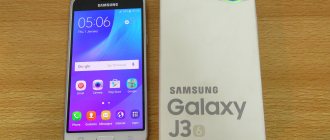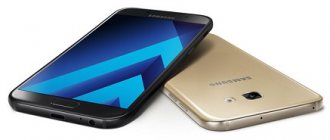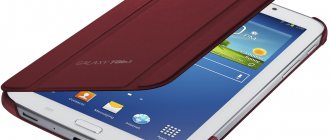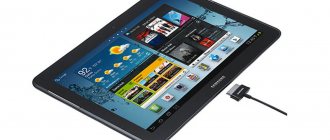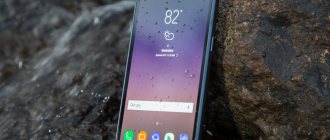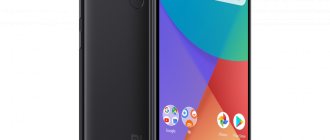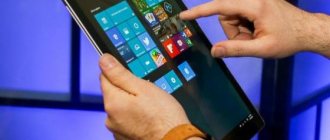Appearance and photos of the smartphone
Advantages and disadvantages of the Galaxy A3 phone
The dimensions of the Samsung Galaxy A3 are 65.5 mm wide, 130.1 mm long and 6.9 mm thick. With such dimensions it is convenient to operate the device with one hand. In addition, the weight of the device is about 110 g. Even if you operate the device with one hand, its weight is almost not felt.
If we evaluate the overall ease of use of the phone taking into account the size and weight, then there will be no problems with everyday use.
The smartphone is equipped with a 4-core Qualcomm Snapdragon 410 MSM8916 processor, which is made at 28 nm. technical process.
The smartphone has only 1 GB. RAM, which is quite small. Instances of low RAM will occur regularly, so even when using light applications you will experience instability in operation.
The device's data storage capacity is 16 GB, and while this is enough for photos, it may not be enough for video shooting and a large number of games.
The phone is compatible with SD cards, so you can easily expand its memory. So you probably don't need to worry about storage capacity.
The Galaxy A3 has a display diagonal of 4.5 inches. The display is large enough that you will rarely have problems with its size. However, this display is not suitable for writing long texts.
In terms of quality, the screen may appear pixelated when displaying a picture or video. It should be sufficient for normal use.
The main camera of the phone has 7.99 megapixels, which should be enough in most cases. However, you may be slightly unsatisfied with the quality of the photos.
Also, the smartphone has a 4.92 megapixel front camera, which is average for smartphone cameras. This is good enough for taking selfies, but you may not be satisfied with group photos or their print quality.
The battery capacity of the Samsung Galaxy A3 is 1900 mAh, which is a common capacity indicator. Compared to other smartphones, the battery life of the Samsung Galaxy A3 is average. You don't have to worry about anything during daily use. However, if you spend time surfing the internet or playing games, you might be a little underwhelmed by the battery life.
Review of Android smartphone Samsung Galaxy A3 (2016): attempt number two
Table of contents
- Introduction
- Specifications
- Packaging and equipment
- Appearance and design
- Display
- Hardware platform and performance
- Software and firmware
- Multimedia
- Wireless Interfaces and Communications
- File system
- Battery life
- Camera
- Comparison with competitors
- Conclusion
- Additional photo examples
Introduction
Samsung models still do not reach us as often and quickly as we would like, but we still have some experience with this manufacturer.
Last year, he launched the Galaxy A line of smartphones on the market, which was purely fashion-oriented and did not claim a place in the pockets of enthusiasts.
As is fashionable these days, the model range within the new line was sorted by size: from the smallest and budget A3 to the large “tablet phone” A7. And at the beginning of this year, the line was replenished with a device with the A9 index and a huge six-inch screen. But now we will talk about the most affordable version - Samsung Galaxy A3 (2016)
Last spring I had the opportunity to test its predecessor, the Samsung Galaxy A3 (SM-A300F), and at that time the device seemed interesting, but slightly overpriced. Let's see what conclusions the manufacturer made and whether he succeeds in attempt number two.
announcements and advertising
2080 Super Gigabyte Gaming OC for 60 rubles.
Compeo.ru - the right comp store without any tricks
RTX 2060 becomes cheaper before the arrival of 3xxx
Ryzen 4000
series included in computers already in Citylink
The price of MSI RTX 2070 has collapsed after the announcement of RTX 3xxx
Core i9 10 series is half the price of the same 9 series
The price of memory has been halved in Regard - it’s more expensive everywhere
Specifications Samsung Galaxy A3 (2016)
| Model | Samsung Galaxy A3 2020 (SM-A310F) | Samsung Galaxy A3 2020 (SM-A300F) |
| Device type | Smartphone | Smartphone |
| CPU | Samsung Exynos 7578(?), 4 x 1500 MHz, Cortex-A53 | Qualcomm Snapdragon 410, 4 x 1200 MHz, Cortex-A53 |
| Video processor | Mali-T720 MP2 | Adreno 306 |
| operating system | Android 5.1 + TouchWiz | Android 4.4.4 + TouchWiz |
| RAM, GB | 1.5 | 1.0 |
| Internal memory, GB | 16 | 16 |
| Screen | 4.7″ SuperAMOLED, HD (1280 x 720) | 4.5" SuperAMOLED, qHD (960 x 540) |
| Cameras, Mpix | 13.0 + 5.0 | 8.0 + 5.0 |
| Net | GSM 850/900/1800/1900 | GSM 850/900/1800/1900 |
| Number of SIM cards, pcs. | 2, one – universal slot | 2, one – universal slot |
| MicroSD support | Eat | Eat |
| Data transfer | Wi-Fi, WAP, GPRS, EDGE, NFC, HSDPA, 3G, LTE | Wi-Fi, WAP, GPRS, EDGE, NFC, HSDPA, 3G, LTE |
| aGPS/GPS/GLONASS/Beidou | Yes/Is/Is/No | Yes/Is/Is/No |
| Battery, mAh | 2 300 | 1 900 |
| Dimensions, mm | 135.0 x 65.0 x 7.0 | 130.0 x 65.5 x 7.0 |
| Weight, g | 132 | 110 |
| price, rub. | ~19 000 | ~15 000 |
The improvements mainly affected the battery; replacing a single-chip system with a similar-class Exynos 7578 is unlikely to give a noticeable gain in performance or even in benchmarks. The unclear situation also concerns the fact that the manufacturer does not officially indicate the model of the single-chip system installed in the device, and our foreign colleagues claim that “under the hood” of the updated version of the Samsung Galaxy A3 (2016) hides the same Qualcomm Snapdragon 410 operating at 1.5 GHz.
In this light, replacing the display with a clearer one does not seem very justified - will the Mali-T720 MP2 graphics accelerator have enough power to run applications smoothly at this resolution?
Packaging and equipment Samsung Galaxy A3 (2016)
Alas, this time we received the smartphone without packaging or delivery. We can assume that the set will be something like this:
- Documentation;
- MicroUSB cable;
- Charger;
- Stereo headset with replaceable pads;
- Tray clip.
True, the stereo headset remains in question - after all, there is a crisis on the street.
Appearance and design of Samsung Galaxy A3 (2016)
Externally, the new version is practically no different from its predecessor. However, if you look closely, you will notice thinner bezels around the display, since the same form factor now houses a 4.7″ screen instead of 4.5″.
There are few changes on the reverse side: numerous inscriptions have disappeared, the calling speaker has “moved” to the bottom end, and the bend of the glass can now be observed not only on the sides, but also on the top and bottom.
The materials used were the same - glass and metal. Users appreciated this approach, and the manufacturer continued to delight fans of “glass and metal sandwiches.” True, it is no longer possible to replace the battery and back cover yourself, as was the case with the Samsung Galaxy S5 mini.
In addition to gold color, users will have access to black, white and pink.
The arrangement of the elements generally remains the same as that of its predecessor, except that the ringing speaker is now located at the bottom end of the device.
The connectors look a little strange, as they are not very accurately centered in the plastic panels. It's unlikely to affect anything, but it doesn't look very neat.
The volume control and screen lock keys remain in the same place, but now they are all made separately. But with the slot for SIM cards and memory cards, the situation is the opposite - instead of two, there is now one, but larger.
True, this still does not prevent it from being a compromise - one of the SIM card slots is again combined with a slot for a memory card.
The quality of workmanship and fitting of parts is slightly better than ours
previously.
The keys are hard to press, with play visible only on the screen lock button.
Alas, as in the previous model, there is no LED event indicator. The rest of the set is classic: light and proximity sensor, front camera and speaker grille.
On the back side we find a rear camera and a flash consisting of a single LED.
There shouldn't be any problems with scratches.
Following fashion trends, and this is important in this segment, the manufacturer installed glass with rounded edges on both sides.
The touch keys are illuminated with not too bright blue LEDs; there should be no problems with their identification. The only thing you may not like is the sound from pressing the “Home” key, which may seem overly loud and ringing.
Visually, the smartphone looks modern and compact. The build quality, as already mentioned, is excellent. In terms of appearance and tactile sensations, the new product is doing well.
Detailed technical specifications
Make and model
Make and model of the device, and alternative names (if any).
| Brand Device manufacturer company. | Samsung |
| Model Device name. | Galaxy A3 |
| Alternative names Other model names, if available. Sometimes the model is called differently, depending on the country or because of popular nicknames. | SM-A300 A300 SM-A3000 A3000 SM-A300F A300F SM-A300FU A300FU SM-A300F/DS |
Design
Appearance of the device including dimensions, weight, volume, colors and materials.
| Width The horizontal side of the device when used in standard orientation. | 65.5 mm (millimeters) |
| Height The vertical side of the device when used in standard orientation. | 130.1 mm (millimeters) |
| Thickness The cross-sectional size of the device. | 6.9 mm (millimeters) |
| Weight How much does the device weigh excluding the case, SIM and memory cards and other additional elements. | 110 g (grams) |
| Volume Approximate value calculated using the formula: length times width times height. | 58.8 cm³ (cubic centimeters) |
| Colors What colors is the device available in? | White Black Silver Pink Blue Gold |
| Housing materials What materials is the body made of? | Metal Glass |
System on a Chip (SoC)
A system on a chip, a single-chip system (System on a Chip, SoC) is when several systems performing different device functions are connected on one chip.
| System on a Chip (SoC) A single-chip system that contains components such as a processor, graphics accelerator, memory units, communication interfaces, etc., as well as software for the operation of the system. | Qualcomm Snapdragon 410 MSM8916 |
Central processing unit (CPU)
| Central processing unit (CPU) The main component of the device is responsible for calculations and data processing. | ARM Cortex-A53 |
| Technical process What technological process is used to make the chip? The smaller the process technology, the better - the chips consume less power and generate less heat. | 28 nm (nanometers) |
| Processor size Processor capacity is a parameter that indicates how many bits of data a processor register processes in 1 clock cycle. This is usually 32 or 64 bits. | 64 bit |
| Instruction Set Architecture Instruction set architecture (ISA) is a programmable part of the microprocessor core used by software to control the operation of the processor. | ARMv8 |
| Number of processor cores The processor can be either single-core or multi-core. The performance of the processor depends on the number of cores (threads). The more cores working simultaneously, the higher the power consumption, so in mobile devices all cores are used only under high load. | 4 |
| CPU clock speed Clock speed is the number of operations per second that a processor or its core can achieve. The higher the frequency, the higher the overall performance of the device, but performance also depends on the processor architecture and the number of cores. | 1200 MHz (megahertz) |
Graphics Processing Unit (GPU)
| Graphics Processing Unit (GPU) The graphics processing unit (GPU) is used to process and display graphics - 3D effects, games, interfaces and other visual elements. Due to the pipeline architecture, the GPU is many times more efficient in graphics processing than the processor. | Qualcomm Adreno 306 |
| GPU clock speed Clock speed is the number of operations per second that the GPU or its core is capable of achieving. The higher the frequency, the higher the speed of the processor, and therefore the number of tasks it can solve. | 400 MHz (megahertz) |
Random access memory (RAM)
| Amount of random access memory (RAM) RAM (Random Access Memory, RAM, RAM) is temporary memory (works only while the device is running), which stores data and code for the operational operation of programs and applications. The more RAM, the more programs you can run simultaneously without loss of performance (there will be fewer “brakes”). | 1 GB (gigabytes) |
| Type of random access memory (RAM) Information about the type of RAM used by the device. | LPDDR3 |
| Number of RAM channels 1 is a single-channel RAM operating mode, basic, when 1 memory module is used. 2 is already a two-channel mode - a mode of parallel operation of 2 modules or pairs of modules, memory channels - this mode is 2 times faster than a single-channel one. 3 – three-channel mode is 3 times faster than single-channel mode. | Single channel |
| RAM frequency The frequency of RAM determines the speed of RAM, or rather the speed of data transfer and reception. In theory, the higher the frequency, the more powerful the RAM. | 533 MHz (megahertz) —- SM-A300FU — 1.5 GB RAM |
Built-in memory
Most mobile devices have built-in Flash memory, which is used as a storage for system data, the operating system, as well as user data - photos, videos, recordings and much more.
| Built-in memory capacity The higher the amount of built-in memory, the more games, programs, music, videos and your other files will fit in the device, especially the amount of memory is important when the device does not support memory cards. | 16 GB (gigabytes) |
Operating system
A mobile operating system (OS) is pre-installed software with a well-thought-out interface for user control of device functions.
| Operating system (OS) The operating system installed by default by the device manufacturer, as well as its version. | Android 4.4.4 KitKat Android 5.0 Lollipop |
| User interface User interface (UI - user interface) is usually a graphical shell that ensures the transfer of information between the user and the operating system. | TouchWiz |
Battery
To operate autonomously, a mobile device requires a battery that powers all its components.
| Battery capacity The main characteristic of a battery is its maximum capacity, that is, the charge it can store. Capacity is measured in mAh (mAh, milliamp-hour). The higher the capacity, the longer the mobile device can work. | 1900 mAh (milliamp-hours) |
| Battery type Many types of batteries have been used in portable devices, but NiCd (nickel-cadmium), NiMH (nickel-metal hydride), and even more so SLA (lead-acid) batteries are already considered obsolete. Instead, modern mobile devices use Li-Ion (lithium-ion) and Li-Pol, Li-Poly (lithium-polymer) batteries. | Li-Ion (Lithium-ion) |
| Call duration on 2G network (GSM, CDMA) Approximately how long will it take for a fully charged battery to discharge when talking in 2G mode. Approximate, because this time is influenced by many factors, such as the operator, signal strength, active applications, and so on. | 12 h (hours) 720 min (minutes) 0.5 days |
| Call duration on 3G network (WCDMA, UMTS, CDMA2000) About how long a fully charged battery will be discharged during a call on third generation networks. Approximate time because it is influenced by various factors, including ambient temperature. | 12 h (hours) 720 min (minutes) 0.5 days |
Screen
The screen (display) is the main element for displaying graphic information.
| Technology The technology used to make the screen. There are many types of display manufacturing with their pros and cons. | Super AMOLED |
| Diagonal The screen diagonal of a device is measured in inches (inch, in or simply ″), and 1″ is equal to 2.54 cm. | 4.5 in (inches) 114.3 mm (millimeters) 11.43 cm (centimeters) |
| Width Approximate screen width | 56.04 mm (millimeters) 5.6 cm (centimeters) |
| Height Approximate screen height | 99.62 mm (millimeters) 9.96 cm (centimeters) |
| Aspect Ratio Aspect ratio is the ratio of the shorter side of the screen, which is considered to be 1, to the longer side, which is denoted by a decimal fraction indicating the ratio to the short side. | 1.778:1 16:9 |
| Screen resolution Screen resolution is the number of horizontal pixels (dots) multiplied by the number of vertical pixels. The higher the resolution, the more detailed the image will be. | 540 x 960 pixels |
| Pixel Density The number of pixels per inch or PPI (pixels per inch) indicates the density of pixels per 1 inch (2.54 cm) of the screen. The higher the PPI, the sharper the image, and the less visible or even invisible “squares and dots” (pixels). | 245 ppi (pixels per inch) 96 ppcm (pixels per centimeter) |
| Color depth Color depth means how many bits are used in 1 pixel to display color (bits per pixel). | 24 bit 16777216 colors |
| Screen area Approximate usable area occupied by the screen on the front of the device. The higher the percentage, the narrower the frames around the display or the smaller the “chin with bangs.” | 65.72% (percent) |
| Touch screen A touch screen is a device that usually covers the display and is a touch input tool. In fact, in mobile devices, the touchscreen is a replacement for the keyboard and mouse. | Yes |
| Touch screen type There are many types of touch screens, with their pros and cons. Mobile devices often use capacitive touchscreens, but technology does not stand still and new types of sensors are appearing. | Capacitive |
| Multi-touch Touch screen support for two or more touches. For example, zooming photos with two fingers. | Yes |
Main camera
The main camera, usually built into the rear of the device, is designed for creating photo and video content.
| Maximum image resolution This is the maximum number of pixels (dots) horizontally and vertically. The higher the resolution, the more detailed the image will be. Resolution can also be indicated in megapixels - this is the total number of pixels that can be in the image, calculated by the formula: vertical pixels multiplied by the number of horizontal pixels and divide the resulting amount by 1 million. | 3264 x 2448 pixels 7.99 MP (megapixels) |
| Matrix type There are two main types of photomatrix, CCD (Charge-Coupled Device) and CMOS (Complimentary Metal-Oxide Semiconductor). Mobile devices mainly use a CMOS matrix - it requires less space, has low power consumption and heating. Recently, new types of sensors have begun to appear, for example PureCel from OmniVision. | CMOS (complementary metal-oxide semiconductor) |
| Diaphragm Aperture (f-number, f) is used to control the light flux passing through the lens. The aperture is indicated by a fraction, and the smaller the fractional number, the higher the aperture passing through the lens. The more light that passes through the lens, the better overall, less noise in your photos and better night photography. | f/2.4 |
| Flash type Most mobile devices are equipped with light-emitting diode (LED) flashes, but there are also xenon flashes. As a flash, xenon is better - it is more powerful, but LED is more versatile (can work as a flashlight) and consumes less electricity. | LED |
| Maximum video resolution This is the maximum number of pixels (dots) horizontally and vertically. The higher the resolution, the more detailed the image will be. | 1920 x 1080 pixels 2.07 MP (megapixels) |
| FPS video recording at maximum resolution FPS (Frames per Second, frame rate) is the number of frames that changes in 1 second. The higher the number of frames per second, the smoother the image will be. In this case, we mean the number of frames that the camera can achieve at its maximum resolution; the lower the resolution, the higher the FPS can be. | 30 fps (frames per second) |
| Presence of flash Incorporating a flash into a mobile device allows you to take pictures in low light conditions. Creates the necessary lighting and compensates for the lack of natural light. | Yes |
| Digital zoom With digital zoom (zoom, enlargement), the subject is brought closer due to software image algorithms. The higher the magnification with digital zoom, the worse the image quality (noise, blur) will be compared to a non-zoomed one. | Yes |
| Focus on face Function of auto-detection of living objects and autofocus on their face or head. | Yes |
| Panoramic shooting mode Panoramic photography is a series of frames where each subsequent frame is a continuation of the previous one; at the end of the shooting, all frames are stitched together at the software level to create a panoramic photograph. Frames can be shot both vertically and horizontally, and their width can be up to 360 degrees. This type of shooting is used when the camera's viewing angle is not enough to capture the entire scene. | Yes |
| HDR shooting mode HDR photography takes a quick series of shots with highlights, midtones, and shadows, then combines them into a single frame with high dynamic range. | Yes |
| Electronic (digital) image stabilizer EIS (Electronic Image Stabilizer - digital image stabilization) is performed using software algorithms and is needed to reduce blurring when the camera shakes. | Yes |
| White balance White balance is a setting that helps ensure the correct color reproduction in an image by determining the color temperature of the light source in the frame. The balance can be set either automatically or manually. | Yes |
| ISO Setting ISO is the level of light sensitivity. The lower the ISO, the less sensitive the camera's light sensor and the smoother the image with less noise. The higher the ISO, the higher the light sensitivity, but more noise, graininess, or decreased sharpness. | Yes |
| Additional Information Additional information about the functions and characteristics of cameras. | Autofocus Continuous shooting Geo-tagging Touch focusing Exposure compensation Scene select mode Macro mode |
Front-camera
The front camera of a mobile device (selfie camera, rear camera) is a camera on the front part, which is usually used for video communication, recognition of gestures or faces, and selfie photographs.
| Photo resolution The maximum image resolution that the camera can produce. As resolution increases, image detail increases. Resolution can also be indicated in megapixels (the total number of pixels that an image can consist of) - these are vertical pixels multiplied by horizontal pixels and divided by 1 million. | 2560 x 1920 pixels 4.92 MP (megapixels) |
Memory card
A memory card (flash card) is an external data storage device that is used in many devices to increase memory capacity.
| Memory card type and formats Mobile devices usually use 3 types of memory cards - SD, miniSD and the most common microSD. Each type has its own formats that the device supports. | microSD microSDHC microSDXC |
SIM card
Subscriber Identification Module (SIM) used in mobile devices to identify subscribers in cellular networks.
| Type, size of SIM card A regular (mini SIM) card has dimensions of 25x15 mm. Micro SIM - 15x12 mm. Nano SIM - 12.3x8.8 mm. The sizes of SIM cards are different and not interchangeable. There is also an eSIM (virtual, electronic SIM card), it is built into the device and does not take up space. | Nano-SIM (4FF - fourth form factor, since 2012, 12.30 x 8.80 x 0.67 mm) |
| Number of SIM cards How many SIM cards does the device support? | 1 |
| Additionally Additional information about the operation of SIM cards in the device. | Dual SIM optional (A version of the model that has two slots for SIM cards.) |
Mobile networks
This is a system in which communication and data transfer is carried out between subscribers, the location of one or more of which changes. This section lists the supported mobile communication standards and frequencies.
| GSM GSM (Global System for Mobile Communications) is a standard for digital mobile cellular communications of the second generation 2G with time and frequency division of channels. GSM came to replace analog cellular communications 1G (first generation). | GSM 850 MHz GSM 900 MHz GSM 1800 MHz GSM 1900 MHz |
| TD-SCDMA TD-SCDMA (Time Division Synchronous Code Division Multiple Access) is a third generation (3G) mobile communications standard used in China. | TD-SCDMA 1880-1920 MHz TD-SCDMA 2010-2025 MHz |
| UMTS UMTS (Universal Mobile Telecommunications System), also called 3GSM, is a third generation (3G) mobile communications standard based on the WCDMA air interface. | UMTS 850 MHz UMTS 900 MHz UMTS 1900 MHz UMTS 2100 MHz |
| LTE LTE (Long-Term Evolution, often referred to as 4G LTE) is a standard for wireless high-speed data transmission, which, although it belongs to fourth generation networks (4G), is essentially a transitional stage from 3G to 4G, greatly accelerating data transfer speeds. The standard has an improved version, LTE Advanced (LTE-A), which can already be considered a full-fledged 4th generation network. | LTE 800 MHz LTE 850 MHz LTE 900 MHz LTE 1800 MHz LTE 2100 MHz LTE 2600 MHz LTE-TDD 1900 MHz (B39) LTE-TDD 2300 MHz (B40) LTE-TDD 2500 MHz (B41) LTE-TDD 2600 MHz (B38) |
Mobile network data standards
What data transfer standards in cellular networks are supported by the device, as well as their speed.
| Data transmission technologies Technologies for receiving and transmitting data, as well as their maximum speed. | UMTS (384 kbit/s) EDGE GPRS HSPA+ (HSUPA 5.76 Mbit/s, HSDPA 42 Mbit/s) LTE Cat 4 (51.0 Mbit/s, 150.8 Mbit/s) |
WiFi
Wi-Fi (Wireless Fidelity) is a technology for wireless data transmission over a local network among devices based on IEEE 802.11 standards.
| Wi-Fi Direct support The Wi-Fi Direct protocol allows multiple devices to connect directly, bypassing the use of routers or access points. | Yes |
| Wi-Fi Hot-Spot A hotspot is a Wi-Fi access point. In a mobile device, Hot-Spot turns the smartphone into a Wi-Fi access point, essentially turning it into a router capable of distributing the Internet. | Yes |
| WiFi Supported WIFI wireless network standards. | 802.11b (IEEE 802.11b-1999) 802.11g (IEEE 802.11g-2003) 802.11n (IEEE 802.11n-2009) |
Bluetooth
Bluetooth (BT, bluetooth (z), “blue tooth”) is a short-range wireless network (up to 10, sometimes 100 meters) operating on radio waves to transmit voice and data between devices.
| Bluetooth version Bluetooth technology is actively developing and, since 1998, has been constantly updating versions of the standard. Each subsequent version introduces one or several improvements in data exchange speed, range, facilitates pairing, reduces power consumption, or introduces some new protocols and operating profiles. The higher the Bluetooth version, the better. The technology is also backward compatible, for example, if your mobile device has version 5.0, then it will work with accessories version 4.2 and lower, but the improvements introduced in version 5.0 will not work; they will work only if both the device and accessories are version 5. | 4.0 |
| Bluetooth Low Energy (BLE) Bluetooth LE is a low energy BT protocol specification. | Yes |
| A2DP profile The A2DP Bluetooth profile is designed to transmit a high-quality two-channel stereo signal via Bluetooth to wireless headphones, speakers and other acoustics. | Yes |
Sensors
Modern devices have many sensors that help in measurements, trigger functions, and make using the device more pleasant.
| Light sensor The light sensor reacts to the light level and is able to adjust the screen brightness automatically based on this. This is necessary to reduce power consumption and ease of use of the device. | Yes |
| Proximity sensor The proximity sensor reacts to the proximity of the mobile device to some object. For example, the sensor is used when talking on the phone to turn off the screen, which saves energy and prevents you from pressing buttons with your ear or cheek. | Yes |
| Accelerometer An accelerometer is a sensor that measures apparent acceleration, that is, it determines the position and distance at which a mobile device moves in space. Based on the data from this sensor, the screen orientation change, pedometer, control using tilts and gestures in games and applications, etc. work. | Yes |
| Hall Sensor The Hall sensor in mobile devices is capable of responding to strengthening and weakening of the magnetic field. It is used to operate Smart cases (cases with a magnet; when the case is closed, the screen turns off or switches to another mode), folding phones, and sometimes, when paired with a magnetometer, it helps the geopositioning system. | Yes |
| Digital compass This is software that displays data from a magnetic sensor or GPS in the form of a compass on the screen of a mobile device. If there are no sensors or GPS, then the digital compass will not work. | Yes |
| Additional sensors |
Audio
Audio - characteristics and capabilities of a mobile device in terms of sound.
| Music speaker There are two types of speakers in mobile devices - auditory and musical. The auditory speaker (speaker) is used for conversation, the music speaker (buzzer) is used to play music and sounds. | Loudspeaker Earphone |
Radio
The radio in a mobile device can be built-in by the manufacturer (catch local radio channels, no internet required, often works only with headphones (as an antenna), but not always) or installed as an online application (requires internet, but more channels and often better quality) .
| Built-in radio Is a radio tuner integrated into the mobile device? | Yes |
Navigation and location
The location is determined by satellite navigation systems that track the device's autonomous geospatial location at multiple points. The most common satellite navigation systems are GPS, GLONASS, and the Chinese BeiDou.
| GPS GPS (Global Positioning System) is a global satellite navigation system that can determine the position of a mobile device, build routes and find the desired object on the map with an accuracy of several meters. | Yes |
| A-GPS A-GPS (Assisted GPS) is an assistive technology that will help you quickly find the location of your cellular device without waiting for satellite data, which is especially important in indoors and cities. Location is determined in various ways, for example, Wi-Fi access points, mobile towers, bluetooth and others. | Yes |
| GLONASS GLONASS is a Russian Global Navigation Satellite System, which is similar to GPS and works in tandem with it, increasing the accuracy and speed of navigation. | Yes |
| Additional navigation systems | BeiDou |
USB connector
USB (Universal Serial Bus) is a serial interface for connecting peripherals to computers, smartphones, laptops and much more. The interface allows you to exchange data and power a peripheral device with energy, as well as connect several peripheral devices to one USB connector at once.
| Connector type What type of USB connector is used in the device. | Micro USB |
| USB standard The higher the standard, the faster the throughput, or more precisely the data exchange rate. With version 3.0 of the standard, the current was increased to 0.9A, eliminating the need for additional power for some devices. | 2.0 |
| USB Mass Storage Connecting a mobile device via USB as a data storage device. That is, when you enable this mode, your device can be used as a flash drive. | Yes |
| Additional characteristics Additional features of the USB connector, for example, OTG, whether the connection is supported, peripheral devices and additional memory. | Charging via USB |
Headphone jack
A TRS headphone jack (or jack) is a common standard of connectors used for transmitting audio signals. By diameter there are jack (6.5 mm), mini-jack (3.5 mm) and micro-jack (2.5 mm). In mobile devices, the 3.5mm jack was considered the most popular and widespread, but recently they began to be removed, leaving only USB connectors, through which headphones are connected with a corresponding plug or using adapters.
| 3.5mm headphone jack Does the device have a 3.5 mm audio jack? | Yes |
Connection and synchronization
Options for synchronizing your mobile device and connecting it to other devices.
| NFC NFC (Near field communication, near contactless communication) is a technology for contactless communication between devices over a short distance. Widely used for contactless payment, in the form of a travel card or pass, and is also used for reading and interacting with NFC tags and for exchanging data between devices. | Yes |
| Connection, synchronization Types of synchronization and connection technologies supported by the device. | Computer sync OTA sync Tethering ANT+ —- |
Browser
A browser is a browser program for viewing sites and their content on the Internet. Through the browser, you can open websites, search for information, download necessary files, watch streaming videos, play browser games, etc.
| Technologies Markup and programming languages supported by the built-in (standard) browser. For mobile devices, you can install additional browser applications if the standard one does not suit you. | HTML HTML5 CSS 3 |
Audio file formats/codecs
Mobile devices support many audio file formats, as well as codecs for playing them.
| Default formats The formats that the mobile device supports out of the box are indicated. But if the device does not support the format you need, then you can try adding support for it. Sometimes support depends on the technical characteristics of the device (“hardware”) and nothing can be added here, but often the ability to process a particular audio format depends on the software part. You can install another audio player or codec set separately. | AAC (Advanced Audio Coding) AAC+ / aacPlus / HE-AAC v1 AMR / AMR-NB / GSM-AMR (Adaptive Multi-Rate, .amr, .3ga) AMR-WB (Adaptive Multi-Rate Wideband, .awb) eAAC+ / aacPlus v2 / HE-AAC v2 FLAC (Free Lossless Audio Codec, .flac) M4A (MPEG-4 Audio, .m4a) MIDI MP3 (MPEG-2 Audio Layer II, .mp3) OGG (.ogg, .ogv, .oga , .ogx, .spx, .opus) WMA (Windows Media Audio, .wma) WAV (Waveform Audio File Format, .wav, .wave) |
Video file formats/codecs
Video file formats that the device supports and is capable of decoding and playing.
| Default formats Video file formats that the device is capable of playing with standard firmware and a standard (built-in) set of programs. Not all formats are supported by default, but you can install a third-party video player and/or set of codecs. | 3GPP (3rd Generation Partnership Project, .3gp) AVI (Audio Video Interleaved, .avi) H.263 H.264 / MPEG-4 Part 10 / AVC video MPEG-4 VC-1 VP8 WMV7 (Windows Media Video 7, .wmv ) WMV8 (Windows Media Video 8, .wmv) |
Camera
The smartphone is equipped with a camera with a main camera resolution of 13 megapixels. The focal power of the lens is f/1.9. Like older models, the Samsung Galaxy A3 2020 has both built-in standard modes and a Pro mode, which involves manual adjustment of most parameters. So, in this mode you can easily adjust ISO, i.e. the light sensitivity of the lens, select the white level, set exposure and much more. The camera interface is also very standard and is unlikely to cause confusion among those who have used Samsung smartphones in recent years.
In addition to the standard ones, the camera is equipped with an HDR mode. If some time ago this mode justifiably seemed useless and ineffective to many users, now HDR often “pulls out” many pictures. On the Samsung Galaxy A3 2020, this mode works very smoothly. After applying HDR, dark holes do not acquire unnatural shades, and highlights do not turn gray.
On the left is a picture without HDR, on the right is with HDR mode
Daytime shooting
During the day, the camera focuses the image very accurately and quickly. The frames are detailed, bright, rich and pleasant. The color gamut of the photographs is close to natural, the range of shades is high and varied. As for the white balance, the camera determines it quite close to the original, i.e., real, picture.
However, it is also noticeable that the smartphone is a junior version of the line. The Samsung Galaxy A3 2020 lacks optical stabilization, due to which, even during the day, pictures can sometimes come out insufficiently clear and blurry in places. In this situation, the quality of the photo directly depends on the stamina and reliability of the hand that holds it. Given the light weight of the product, as well as its size, trying to take a good, clear photo becomes a serious task. And in conditions of night shooting or indoor shooting, it becomes even more difficult.
Photo gallery: daytime shooting
During the day, the camera focuses the image very accurately and quickly
The frames are detailed, bright, rich and pleasant
The color gamut of the photographs is close to natural
Daytime shooting in bright light shows excellent results
In darker lighting the camera starts to act up a bit.
Light transmission and white balance are clearly aligned in auto mode, but you can adjust them yourself
The Samsung Galaxy A3 2020 lacks optical stabilization, due to which, even during the day, pictures may sometimes not be clear enough
There are also no special complaints about macro photography - the images are clear and detailed
Macro shots are just as rich and vibrant as in normal mode
Shooting in low light and at night
Surprisingly, shooting in low light produces results that are not much worse than daytime shots. Noise begins to appear in the resulting images, and the clarity and detail of the picture decreases somewhat. At high magnification, the effects of the noise reduction algorithm built into the system become visible - small parts, for example, tree branches, distant objects, become barely distinguishable. Also, don’t forget about the lack of an optical stabilizer - when taking pictures, you need to hold the phone with a firm and confident hand, or even better, find a fulcrum to minimize the shaking of the device. However, in general, if you get used to it and take a series of photos “to choose from”, it is not so difficult to achieve decent shots. If we consider that we are holding in our hands the junior model of the middle range of smartphones, then there is practically nothing to complain about.
Photo gallery: examples of photographs taken in low light conditions
Even at night, brightly lit objects do not have overexposure and neon tones. Images begin to make noise, but this can be corrected using the Pro mode. At high magnification, the effects of the noise reduction algorithm built into the system become visible - small parts, for example, tree branches, distant objects, become barely distinguishable When shooting in poor lighting, the clarity and detail of the image is somewhat reduced. Noise begins to appear in the resulting images. Due to the lack of optical stabilization, when shooting, the phone must be held with a firm and confident hand. If you get used to it and take a series of pictures “to choose from,” it’s not so difficult to achieve decent frames
Front-camera
The front camera of the phone has a resolution of 8 megapixels and an aperture equal to the main camera, f/1.9. The quality of the camera is slightly worse than its companion on the other hand, but this does not prevent you from getting pretty decent selfies.
The front camera of the phone has a resolution of 8 megapixels and an aperture equal to the main camera, f/1.9
The Samsung Galaxy A3 2020 carries over the same convenience in handling the front camera as its older S-series brothers. You can switch from camera to camera with a simple swipe on the display, take pictures with a quick touch of the screen, or shoot using a voice command or gesture.
With the updated front camera, you don't have to worry about the quality of your pictures - they will be beautiful
Video
The Samsung Galaxy A3 2020 shoots videos in FullHD quality, with a frame rate of 30 fps. The user has access to a panorama mode, as well as a Pro mode with the same settings as the camera.
